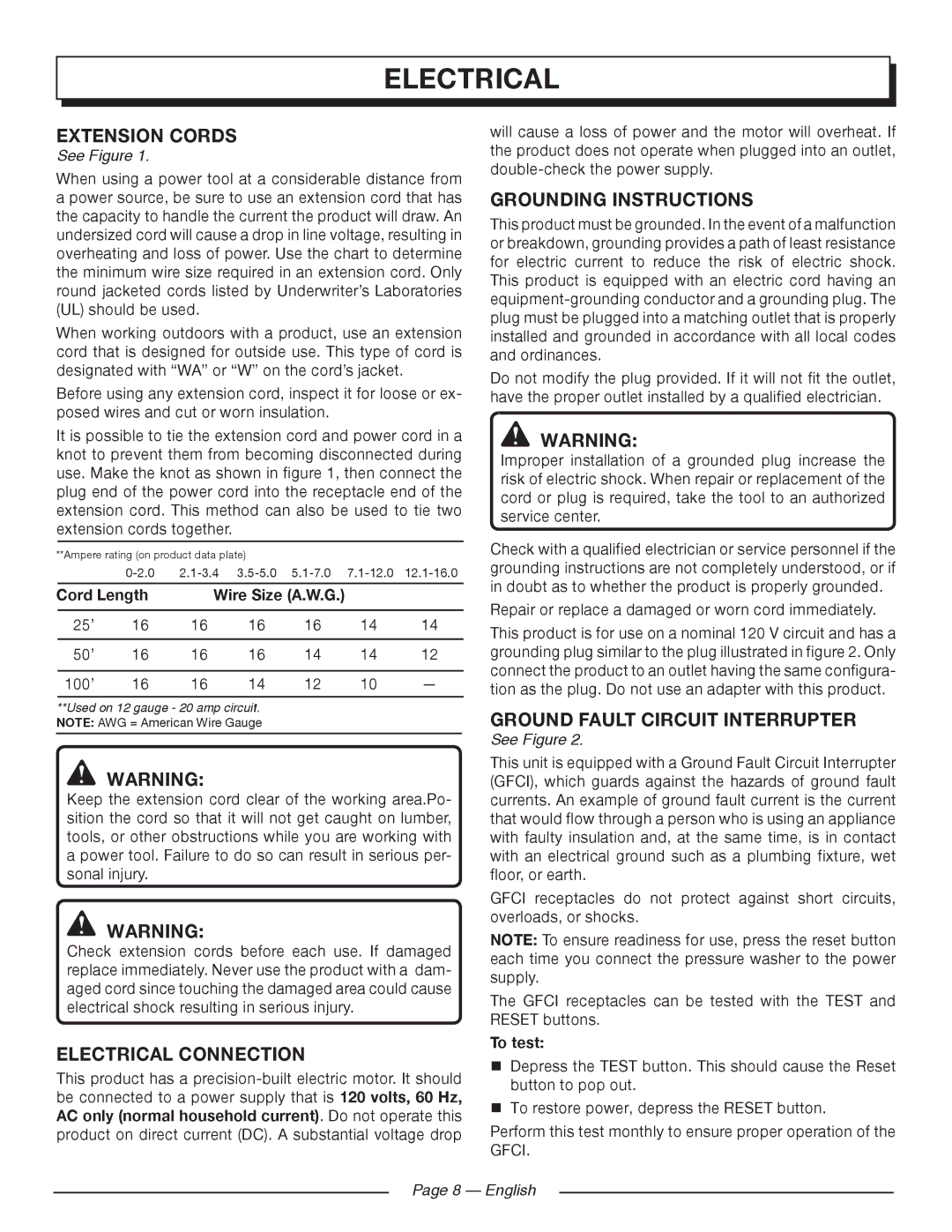
ELECTRICAL
EXTENSION CORDS
See Figure 1.
When using a power tool at a considerable distance from a power source, be sure to use an extension cord that has the capacity to handle the current the product will draw. An undersized cord will cause a drop in line voltage, resulting in overheating and loss of power. Use the chart to determine the minimum wire size required in an extension cord. Only round jacketed cords listed by Underwriter’s Laboratories (UL) should be used.
When working outdoors with a product, use an extension cord that is designed for outside use. This type of cord is designated with “WA” or “W” on the cord’s jacket.
Before using any extension cord, inspect it for loose or ex- posed wires and cut or worn insulation.
It is possible to tie the extension cord and power cord in a knot to prevent them from becoming disconnected during use. Make the knot as shown in figure 1, then connect the plug end of the power cord into the receptacle end of the extension cord. This method can also be used to tie two extension cords together.
**Ampere rating (on product data plate)
Cord Length |
| Wire Size (A.W.G.) |
|
| ||
|
|
|
|
|
|
|
25’ | 16 | 16 | 16 | 16 | 14 | 14 |
|
|
|
|
|
|
|
50’ | 16 | 16 | 16 | 14 | 14 | 12 |
|
|
|
|
|
|
|
100’ | 16 | 16 | 14 | 12 | 10 | — |
**Used on 12 gauge - 20 amp circuit. NOTE: AWG = American Wire Gauge
WARNING:
Keep the extension cord clear of the working area.Po- sition the cord so that it will not get caught on lumber, tools, or other obstructions while you are working with a power tool. Failure to do so can result in serious per- sonal injury.
WARNING:
Check extension cords before each use. If damaged replace immediately. Never use the product with a dam- aged cord since touching the damaged area could cause electrical shock resulting in serious injury.
ELECTRICAL CONNECTION
This product has a
will cause a loss of power and the motor will overheat. If the product does not operate when plugged into an outlet,
Grounding Instructions
This product must be grounded. In the event of a malfunction or breakdown, grounding provides a path of least resistance for electric current to reduce the risk of electric shock. This product is equipped with an electric cord having an
Do not modify the plug provided. If it will not fit the outlet, have the proper outlet installed by a qualified electrician.
WARNING:
Improper installation of a grounded plug increase the risk of electric shock. When repair or replacement of the cord or plug is required, take the tool to an authorized service center.
Check with a qualified electrician or service personnel if the grounding instructions are not completely understood, or if in doubt as to whether the product is properly grounded.
Repair or replace a damaged or worn cord immediately.
This product is for use on a nominal 120 V circuit and has a grounding plug similar to the plug illustrated in figure 2. Only connect the product to an outlet having the same configura- tion as the plug. Do not use an adapter with this product.
Ground fault circuit interrupter
See Figure 2.
This unit is equipped with a Ground Fault Circuit Interrupter (GFCI), which guards against the hazards of ground fault currents. An example of ground fault current is the current that would flow through a person who is using an appliance with faulty insulation and, at the same time, is in contact with an electrical ground such as a plumbing fixture, wet floor, or earth.
GFCI receptacles do not protect against short circuits, overloads, or shocks.
NOTE: To ensure readiness for use, press the reset button each time you connect the pressure washer to the power supply.
The GFCI receptacles can be tested with the TEST and RESET buttons.
To test:
Depress the TEST button. This should cause the Reset button to pop out.
To restore power, depress the RESET button.
Perform this test monthly to ensure proper operation of the GFCI.
Page 8 — English
